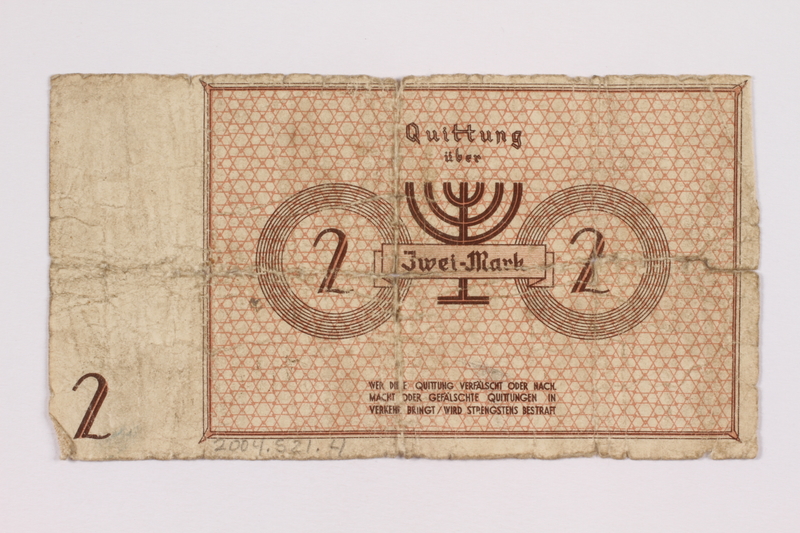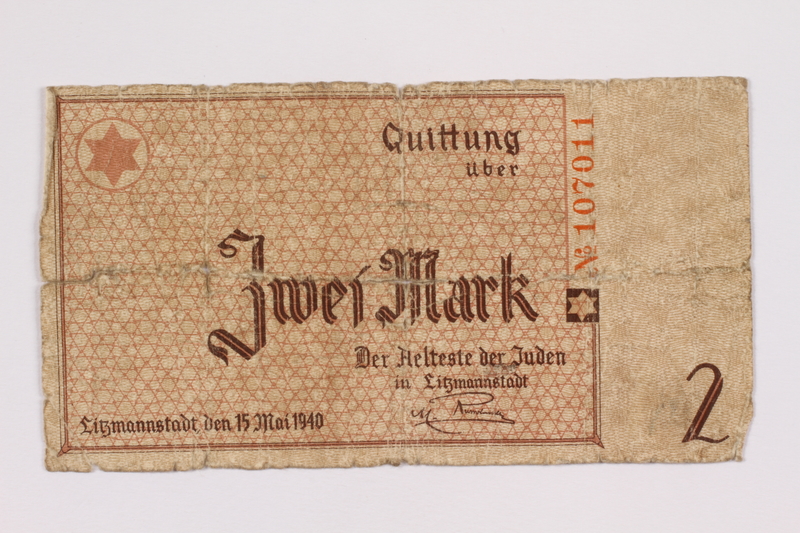Overview
- Brief Narrative
- Scrip receipt for 2 marks issued to Marian Rokacz when he was imprisoned in the ghetto in Łódź, Poland. Nazi Germany occupied Poland on September 1, 1939. Łódź was renamed Litzmannstadt and, in February 1940, the Germans forcibly relocated the large Jewish population into a sealed ghetto. All currency was confiscated in exchange for Quittungen [receipts] that could be exchanged only in the ghetto. The scrip was designed by the Judenrat [Jewish Council] and includes traditional Jewish symbols. The Germans closed the ghetto in the summer of 1944 by deporting the residents to concentration camps or killing centers. Marian had assumed the identity of a Christian Pole and worked for the Germans during the occupation.
- Date
-
issue:
1940 May 15
- Geography
-
issue:
Litzmannstadt-Getto (Łódź, Poland);
Łódź (Poland)
- Credit Line
- United States Holocaust Memorial Museum Collection, Gift of John Rokacz and Joseph Rokacz
- Markings
- face, serial number, upper right, orange ink : Nº 107011
face, upper right, brown ink : Quittung / über [Receipt for]
face, center, brown and pink ink : Zwei Mark [Two Mark]
face, lower right, brown ink : Der Aelteste der Juden / in Litzmannstadt / M. Rumkowski [The Eldest of the Jews in Litzmannstadt]
face, lower left, brown ink : Litzmannstadt, den 15 Mai 1940 [Litzmannstadt, the 15 May 1940]
face, lower right corner, brown and pink ink : 2
back, upper center, brown ink : Quittung / über [Receipt for]
back, center, brown ink : Zwei-Mark [Two-Mark]
back, left and right, brown and pink ink : 2
back, lower center, brown ink : WER D[illegible]E QUITTUNG VERFÄLSCHT ODER NACH. / MACHT ODER GEFÄLSCHTE QUITTUNGEN IN / VERKEH[R] BRINGT / WIRD STRENGSTENS BESTRAFT [ANYONE WHO FALSIFIES OR COPIES THIS RECEIPT, OR TRAFFICS IN COUNTERFEIT RECEIPTS, WILL BE STRICTLY PUNISHED]
back, lower left corner, brown and pink ink : 2 - Contributor
-
Subject:
Marian Rokacz
- Biography
-
Marian Rokacz was born on December 14, 1910, in Poland. He was a resident of the Łódź before the war. Marian married Eva Honigbaum, who was born on August 23, 1916. Poland was invaded by Nazi Germany in September 1939. In February 1940, the German forcibly relocated the Jewish residents to a sealed ghetto. Marian assumed the identity of a Christian Pole and worked for the Germans during the war. After the liberation of the city by Russian troops, they were able to return to the large apartment in which they had lived before the war. The couple immigrated to the United States in March 1953 and had two sons. Marian, age 86, passed away in March 1987. Eva, age 88, died on October 13, 2004.
Physical Details
- Language
- German
- Classification
-
Exchange Media
- Category
-
Money
- Object Type
-
Scrip (aat)
- Physical Description
- Rectangular, offwhite paper scrip. The face has a graphic background design in light brown ink. The denomination 2 is in the lower right corner in bold font. There is a 1.25 inch right margin, then a rectangle with a background of interlocked Stars of David with a large star in a circle in the upper left corner and a smaller one in the center of the right side border in pink ink. Across the center is the textual denomination with German text above and below and an engraved signature on the lower right. The serial number in orange ink replaces the upper right border. The back has a blank background with the denomination 2 in bold font in the lower left corner. There is a 1.25 inch left margin, then a rectangle with a background of interlocked Jewish stars in pink ink with 2 sets of 9 concentric rings in brown ink with the numerical denomination in the center. A banner with the textual denomination connects the rings. The banner crosses over a 7-branched candelabrum in the center with German text above and below.
- Dimensions
- overall: Height: 2.625 inches (6.668 cm) | Width: 4.875 inches (12.383 cm)
- Materials
- overall : paper, ink
Rights & Restrictions
- Conditions on Access
- No restrictions on access
- Conditions on Use
- No restrictions on use
Keywords & Subjects
Administrative Notes
- Legal Status
- Permanent Collection
- Provenance
- The scrip was donated to the United States Holocaust Memorial Museum in 2004 by John Rokacz and Joseph Rokacz, the sons of Marian Rokacz.
- Funding Note
- The cataloging of this artifact has been supported by a grant from the Conference on Jewish Material Claims Against Germany.
- Record last modified:
- 2022-08-30 12:01:57
- This page:
- https://collections.ushmm.org/search/catalog/irn522327
Download & Licensing
In-Person Research
- By Appointment
- Request 21 Days in Advance of Visit
- Plan a Research Visit
- Request to See This Object
Contact Us
Also in Marian Rokacz collection
The collection consists of nine pieces of Łódź ghetto scrip relating to the experiences of Marian Rokacz as a detainee in the ghetto in Łódź (Litzmannstadt), Poland, during the Holocaust.
Date: 1940
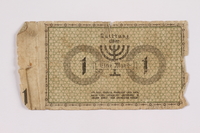
Łódź (Litzmannstadt) ghetto scrip, 1 mark note, acquired by an inmate
Object
Scrip receipt for 1 mark issued to Marian Rokacz when he was imprisoned in the ghetto in Łódź, Poland. Nazi Germany occupied Poland on September 1, 1939. Łódź was renamed Litzmannstadt and, in February 1940, the Germans forcibly relocated the large Jewish population into a sealed ghetto. All currency was confiscated in exchange for Quittungen [receipts] that could be exchanged only in the ghetto. The scrip was designed by the Judenrat [Jewish Council] and includes traditional Jewish symbols. The Germans closed the ghetto in the summer of 1944 by deporting the residents to concentration camps or killing centers. Marian had assumed the identity of a Christian Pole and worked for the Germans during the occupation.
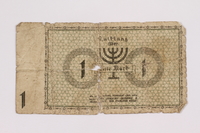
Łódź (Litzmannstadt) ghetto scrip, 1 mark note, acquired by an inmate
Object
Scrip receipt for 1 mark issued to Marian Rokacz when he was imprisoned in the ghetto in Łódź, Poland. Nazi Germany occupied Poland on September 1, 1939. Łódź was renamed Litzmannstadt and, in February 1940, the Germans forcibly relocated the large Jewish population into a sealed ghetto. All currency was confiscated in exchange for Quittungen [receipts] that could be exchanged only in the ghetto. The scrip was designed by the Judenrat [Jewish Council] and includes traditional Jewish symbols. The Germans closed the ghetto in the summer of 1944 by deporting the residents to concentration camps or killing centers. Marian had assumed the identity of a Christian Pole and worked for the Germans during the occupation.
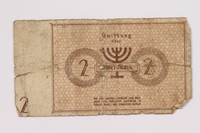
Łódź (Litzmannstadt) ghetto scrip, 2 mark note, acquired by an inmate
Object
Scrip receipt for 2 marks issued to Marian Rokacz when he was imprisoned in the ghetto in Łódź, Poland. Nazi Germany occupied Poland on September 1, 1939. Łódź was renamed Litzmannstadt and, in February 1940, the Germans forcibly relocated the large Jewish population into a sealed ghetto. All currency was confiscated in exchange for Quittungen [receipts] that could be exchanged only in the ghetto. The scrip was designed by the Judenrat [Jewish Council] and includes traditional Jewish symbols. The Germans closed the ghetto in the summer of 1944 by deporting the residents to concentration camps or killing centers. Marian had assumed the identity of a Christian Pole and worked for the Germans during the occupation.
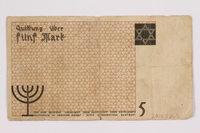
Łódź (Litzmannstadt) ghetto scrip, 5 (funf) mark note, acquired by an inmate
Object
Scrip receipt for 5 marks issued to Marian Rokacz when he was imprisoned in the ghetto in Łódź, Poland. Nazi Germany occupied Poland on September 1, 1939. Łódź was renamed Litzmannstadt and, in February 1940, the Germans forcibly relocated the large Jewish population into a sealed ghetto. All currency was confiscated in exchange for Quittungen [receipts] that could be exchanged only in the ghetto. The scrip was designed by the Judenrat [Jewish Council] and includes traditional Jewish symbols. The Germans closed the ghetto in the summer of 1944 by deporting the residents to concentration camps or killing centers. Marian had assumed the identity of a Christian Pole and worked for the Germans during the occupation.
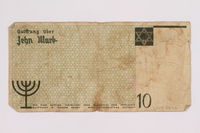
Łódź (Litzmannstadt) ghetto scrip, 10 mark note, acquired by an inmate
Object
Scrip receipt for 10 marks issued to Marian Rokacz when he was imprisoned in the ghetto in Łódź, Poland.Nazi Germany occupied Poland on September 1, 1939. Łódź was renamed Litzmannstadt and, in February 1940, the Germans forcibly relocated the large Jewish population into a sealed ghetto. All currency was confiscated in exchange for Quittungen [receipts] that could be exchanged only in the ghetto. The scrip was designed by the Judenrat [Jewish Council] and includes traditional Jewish symbols. The Germans closed the ghetto in the summer of 1944 by deporting the residents to concentration camps or killing centers. Marian had assumed the identity of a Christian Pole and worked for the Germans during the occupation.
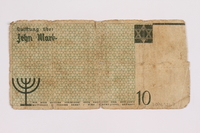
Łódź (Litzmannstadt) ghetto scrip, 10 mark note, acquired by an inmate
Object
Scrip receipt for 10 marks issued to Marian Rokacz when he was imprisoned in the ghetto in Łódz, Poland. Nazi Germany occupied Poland on September 1, 1939. Łódź was renamed Litzmannstadt and, in February 1940, the Germans forcibly relocated the large Jewish population into a sealed ghetto. All currency was confiscated in exchange for Quittungen [receipts] that could be exchanged only in the ghetto. The scrip was designed by the Judenrat [Jewish Council] and includes traditional Jewish symbols. The Germans closed the ghetto in the summer of 1944 by deporting the residents to concentration camps or killing centers. Marian had assumed the identity of a Christian Pole and worked for the Germans during the occupation.
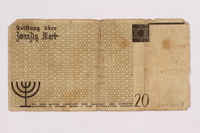
Łódź (Litzmannstadt) ghetto scrip, 20 mark note, acquired by a ghetto inmate
Object
Scrip receipt for 20 marks issued to Marian Rokacz when he was imprisoned in the ghetto in Łódz, Poland. Nazi Germany occupied Poland on September 1, 1939. Łódź was renamed Litzmannstadt and, in February 1940, the Germans forcibly relocated the large Jewish population into a sealed ghetto. All currency was confiscated in exchange for Quittungen [receipts] that could be exchanged only in the ghetto. The scrip was designed by the Judenrat [Jewish Council] which administered the ghetto for the Germans and includes traditional Jewish symbols. The Germans closed the ghetto in the summer of 1944 by deporting the residents to concentration camps or killing centers. Marian had assumed the identity of a Christian Pole and worked for the Germans during the occupation.
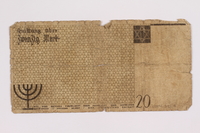
Łódź (Litzmannstadt) ghetto scrip, 20 mark note, acquired by an inmate
Object
Scrip receipt for 20 marks issued to Marian Rokacz when he was imprisoned in the ghetto in Łódź, Poland. Nazi Germany occupied Poland on September 1, 1939. Łódź was renamed Litzmannstadt and, in February 1940, the Germans forcibly relocated the large Jewish population into a sealed ghetto. All currency was confiscated in exchange for Quittungen [receipts] that could be exchanged only in the ghetto. The scrip was designed by the Judenrat [Jewish Council] and includes traditional Jewish symbols. The Germans closed the ghetto in the summer of 1944 by deporting the residents to concentration camps or killing centers. Marian had assumed the identity of a Christian Pole and worked for the Germans during the occupation.

